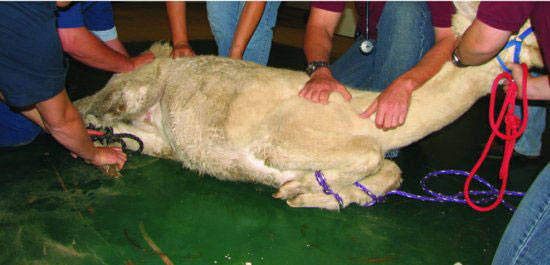Nonsurgical Correction of Uterine Torsion
Uterine torsion can be corrected either with medical or surgical intervention. Medical intervention generally entails rolling the female while stabilizing the uterus to “untwist” the torsion. Transvaginal correction can be done if cervical dilation is sufficient for entry of a hand into the uterus alongside of the fetus. If sedation is needed to roll the dam, a mixed agonist-antagonist narcotic (e.g., butorphanol, 0.05 to 0.1 mg/kg IV) is recommended to minimize cardiopulmonary effects on the dam and fetus. The rolling procedure is done by placing the dam on the same side as the direction of the torsion. A halter is placed on the patient, and ropes are placed on the front and hind limbs to aid in control of the limbs during the procedure (Figure 58.2). For example, if an alpaca has a clockwise uterine torsion, then the alpaca would be placed on her right side to begin the procedure (Figure 58.3). Then, transabdominal palpation is used to identify and stabilize the gravid horn of the uterus by feeling the fetus (Figure 58.4). Most often, the backbone of the fetus is present along the abdominal wall. While maintaining pressure on the gravid horn, the female is rolled over her back to her other side (Figures 58.5 to 58.7). This procedure may need to be repeated. A rectal examination is done after each attempt to determine the extent of correction (Figure 58.8). Correction of the torsion is confirmed by palpating the broad ligaments, uterine body, and fetus. If rolling is successful, the dam should be walked but not allowed to roll for 30 minutes to 1 hour and then reexamined. Uterine torsion often reoccurs within a short period of time in up to 20% of females. This may be associated with incomplete correction during the rolling procedure. If rolling is not successful, a decision should be made quickly regarding surgical correction.
Stay updated, free articles. Join our Telegram channel

Full access? Get Clinical Tree



